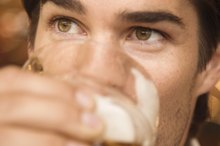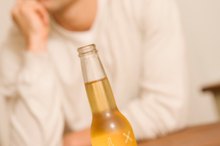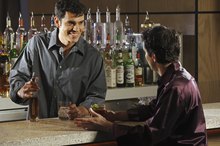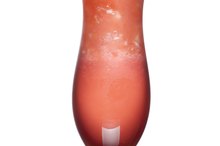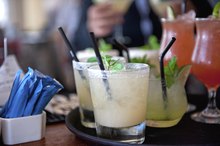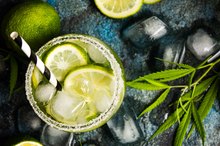What does fact checked mean?
At Healthfully, we strive to deliver objective content that is accurate and up-to-date. Our team periodically reviews articles in order to ensure content quality. The sources cited below consist of evidence from peer-reviewed journals, prominent medical organizations, academic associations, and government data.
The information contained on this site is for informational purposes only, and should not be used as a substitute for the advice of a professional health care provider. Please check with the appropriate physician regarding health questions and concerns. Although we strive to deliver accurate and up-to-date information, no guarantee to that effect is made.
Effects of Alcohol on Skin
An occasional drink while out with friends may not affect you much, but continually abusing alcohol will show on your face the next morning and possibly in the long term 2. Alcohol can do a number on your skin, making it look dry, dull and patchy. If you are concerned with your appearance, drinking should be done on an occasional basis only and avoided when possible to preserve healthy, plump, young-looking skin.
Blotchy Redness
You can often tell a heavy drinker by the tone and color of his face. Alcohol can cause broken capillaries in the face, resulting in a flushed and blotchy appearance, says clinical psychologist Michaele P. Dunlap. Drinking also makes your skin more susceptible to flushing and blushing, especially in the warm conditions of an overcrowded bar. A red face often persists well into the morning as a sign of a serious hangover.
- You can often tell a heavy drinker by the tone and color of his face.
- Drinking also makes your skin more susceptible to flushing and blushing, especially in the warm conditions of an overcrowded bar.
Dryness
Does Drinking Alcohol Cause Nose Pimples?
Learn More
When you drink alcohol, the blood vessels in your face can become restricted and stop delivering the amount of oxygenated blood to your skin that is necessary to keep it feeling hydrated. If you drink frequently, you may notice that your skin is dryer than normal or more susceptible to wrinkles through expression lines. This is because your skin is undernourished and starving for hydration through water.
Puffiness
Drinking alcohol can cause you to gain weight and retain water, thanks to high-calorie, nonnutritional drinks that are full of sugary syrups. Drinking can also lower your resolve when it comes to dieting, meaning that even the most astute health enthusiast can indulge in unhealthy foods while under the influence of alcohol. The result is a puffy, unhealthy look with dry skin and a noticeable lack of facial glow, according to Radford University 2.
Breakouts
Facial Skin Problems Related to Alcohol
Learn More
The American Academy of Family Physicians warns against excessive drinking when you are concerned about the clarity of your skin 3. Alcohol can cause you to break out and have to deal with acne, whiteheads and other skin lesions. Excessive drinking may cause excess hormones in the body. Those hormones activate the sebaceous glands that cause your skin to overproduce oil on your skin, resulting in a broken out and pimply face.
- The American Academy of Family Physicians warns against excessive drinking when you are concerned about the clarity of your skin 3.
- Those hormones activate the sebaceous glands that cause your skin to overproduce oil on your skin, resulting in a broken out and pimply face.
Bruising
The Daily Mail points out that drinking alcohol depletes your body of vitamin C, which is necessary for quick healing 4. Because of the lack of vitamin C, you may be more prone to bruises than normal when consuming excessive amounts of alcohol. The dehydration of the skin also means that it is less likely to cushion against injuries.
Related Articles
References
- Radford University: The Affect Of Alcohol On You
- American Academy of Family Physicians: Drinking: Facts for Teens
- The Daily Mail: How Alcohol Affects the Body
- Claridge LC. Drugs and harm to society. The Lancet. 2011;37(9765):552. doi:10.1016/S0140-6736(11)60194-3
- National Institute on Alcohol Abuse and Alcoholism. Drinking Levels Defined.
- Centers for Disease Control and Prevention. Binge drinking is a serious but preventable public health problem. Updated December 30, 2019.
- Maimaris W, Mccambridge J. Age of first drinking and adult alcohol problems: systematic review of prospective cohort studies. J Epidemiol Community Health. 2014;68(3):268-74. doi:10.1136/jech-2013-203402
- Arain M, Haque M, Johal L, et al. Maturation of the adolescent brain. Neuropsychiatr Dis Treat. 2013;9:449-61. doi:10.2147/NDT.S39776
- Dang JN. Washington, DC: U.S. Department of Transportation - National Highway Traffic Safety Administration technical report. Statistical analysis of alcohol-related driving trends, 1982-2005. 2008.
- U.S. Department of Transportation National Highway Traffic Safety Administration. Results of the 2013–2014 National Roadside Survey of Alcohol and Drug Use by Drivers. Traffic Safety Facts. February 2015.
- Fell JC, Voas RB. The effectiveness of a 0.05 blood alcohol concentration (BAC) limit for driving in the United States. Addiction. 2014;109(6):869-74. doi:10.1111/add.12365
- Agius P, Taft A, Hemphill S, Toumbourou J, Mcmorris B. Excessive alcohol use and its association with risky sexual behaviour: a cross-sectional analysis of data from Victorian secondary school students. Aust N Z J Public Health. 2013;37(1):76-82. doi:10.1111/1753-6405.12014
- National Institute on Alcohol Abuse and Alcoholism. College Drinking. Updated February 2020.
- Thomas S. American Addiction Centers. The Effects of Alcohol on the Body. October 24, 2019.
- Centers for Disease Control and Prevention. Alcohol and Cancer. July 8, 2019.
- Mirijello A, D'angelo C, Ferrulli A, et al. Identification and management of alcohol withdrawal syndrome. Drugs. 2015;75(4):353-65. doi:10.1007/s40265-015-0358-1
- Centers for Disease Control and Prevention. Vital Signs: Alcohol Poisoning Deaths — United States, 2010–2012. January 2015.
- National Institute on Alcohol Abuse and Alcoholism. Understanding the Dangers of Alcohol Overdose.
- Gudin JA, Mogali S, Jones JD, Comer SD. Risks, management, and monitoring of combination opioid, benzodiazepines, and/or alcohol use. Postgrad Med. 2013;125(4):115-30. doi:10.3810/pgm.2013.07.2684
- Melemis SM. Relapse Prevention and the Five Rules of Recovery. Yale J Biol Med. 2015;88(3):325-32.
Writer Bio
Kay Ireland specializes in health, fitness and lifestyle topics. She is a support worker in the neonatal intensive care and antepartum units of her local hospital and recently became a certified group fitness instructor.
